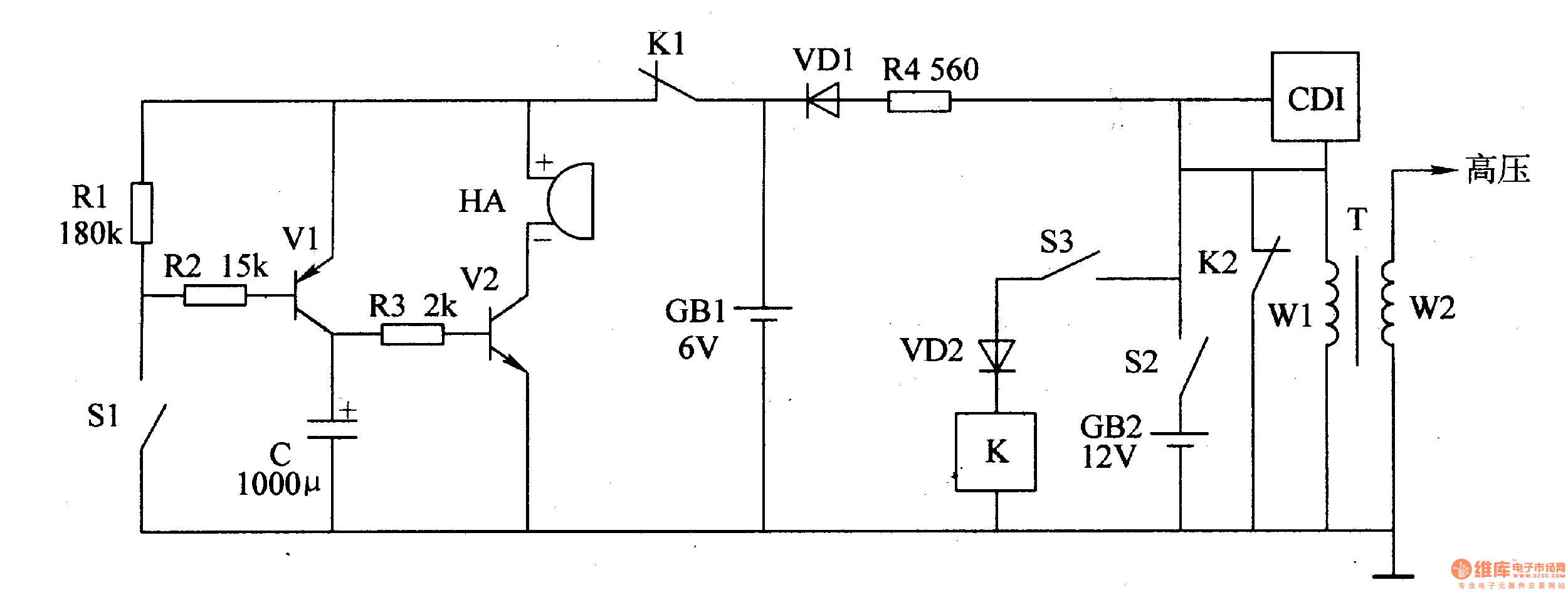
Programmable Home Security Alarm System

A low-cost, high-performance programmable home security system utilizing a few LDRs as input sensors. When the sensors are triggered, the system can dial a user-specified phone number using a built-in DTMF generator and activate a high-power audio alarm and lights. All parameters for the DTMF generator, audio alarm, and light interface can be programmed through an RS232 serial interface. The current firmware offers an interactive control system through the RS232 interface, which features menu-driven configuration options, self-tests, and system report generation. The system includes a 5W audio alarm with four speakers and three selectable tone configurations: Police siren, Fire engine siren, and Ambulance siren. It employs Microchip's PIC16F877A as the main controller, LM339 as the sensor interface, UM3561 as the tone generator, and PC2002 as the speaker driver (audio amplifier). Voltage regulators LM7805, LM7812, and LM317 are used to provide +5V, +12V, and +3V, respectively. The PCB design simplifies assembly; however, caution is required as the PCB contains 230V AC main lines. All photoelectric sensors, switches, and the alarm speaker are connected through connector bars. The PHONE/LINE connector accepts a standard RJ12/RJ11 telephone cable; one port connects to the phone line, while the other is optional for a phone. The Reset Switch allows for a system reset when the audible alarm is activated, although it cannot be used during phone dialing or ringer states. After ensuring all connections are correct, the power supply should be disconnected before inserting IC1, IC2, IC3, and IC4 into their respective IC bases. A suitable speaker should be attached to X4, and the RS232 cable connected to the system. The PuTTY configuration setup includes R6 for X1 sensor sensitivity, R8 for X2 sensor sensitivity, and R4 as the sensor gain controller (common mode).
This programmable home security system is designed to provide effective monitoring and alerting capabilities in residential settings. The system's reliance on LDRs as sensors allows for light-sensitive detection, making it suitable for detecting unauthorized entry during low-light conditions. The integration of a DTMF generator enables the system to communicate with the user via telephone, providing real-time alerts that can be crucial for prompt response.
The choice of components reflects a balance between performance and cost-efficiency. The PIC16F877A microcontroller serves as the core processing unit, managing inputs from the sensors and controlling output functions. The LM339 comparator is utilized for sensor interfacing, allowing for precise detection of light levels and triggering the alarm system accordingly. The UM3561 tone generator provides audible alerts, with selectable tones enhancing the system's versatility in alarm signaling.
Power management is effectively handled by the LM series voltage regulators, ensuring stable operation across the various components. The PCB design is critical, as it not only facilitates assembly but also ensures safety by isolating high-voltage components from user-accessible areas.
The RS232 interface is an essential feature, providing a user-friendly method for configuration and monitoring. Users can navigate through menus to adjust settings, conduct self-tests, and generate reports, thereby enhancing the overall usability of the system. The inclusion of a reset switch adds a layer of control, allowing users to quickly disable the alarm if necessary.
Overall, this home security system exemplifies a well-thought-out design that emphasizes reliability, user interaction, and effective monitoring, making it a valuable addition to any home security strategy.A low cost high performance programmable home security system using few LDR`s as an input sensors. When above sensor(s) get triggered system may dial the user specified phone number (using build-in DTMF generator) and activate the high power audio alarm and lights. All the parameters of DTMF generator, audio alarm and light interface are programmed through the RS232 serial interface.
Current firmware of this system presents interactive control system through the RS232 interface. This control system consist with the menu driven configuration options, self tests, system report generators, etc. This system also contain 5W (with 4 © speaker) audio alarm with three selectable tone configurations, which include Police siren, Fire engine siren and Ambulance siren.
his system uses a Microchip`s PIC16F877A as a main controller, LM339 as sensor interface, UM3561 as a tone generator and PC2002 as a speaker driver (audio amplifier). LM7805, LM7812 and LM317 voltage regulators are used to obtain +5V, +12V and +3V respectively. The PCB design given with this article makes the assembly much simpler. As PCB contain 230V AC main lines care must be taken while assembling the circuit. As shown in the fig all the photoelectric sensors, some of the switches and alarm speaker are connected with the circuit through the connector bars.
PHONE/LINE connector : Attach standard RJ12/RJ11 telephone cable connector to this port. One port is need to use with the phone line and remaining port is for the phone (and it is optional). Reset Switch : Press this button to reset entire alarm system. This button enable only when the audible alarm get activated. It is not possible to use this function at the phone dialing/ringer states. 6. If all the above Step 3, 4 and 5 are correct, disconnect the power supply and insert IC1, IC2, IC3 and IC4 in to the appropriate IC bases.
Attach suitable speaker to the X4 and connect RS232 cable to the system. PuTTY configuration setup for Programmable Home Security Alarm System * R6 X1 sensor sensitivity, R8 X2 sensor sensitivity, R4 sensor gain controller (Common mode) 🔗 External reference
This programmable home security system is designed to provide effective monitoring and alerting capabilities in residential settings. The system's reliance on LDRs as sensors allows for light-sensitive detection, making it suitable for detecting unauthorized entry during low-light conditions. The integration of a DTMF generator enables the system to communicate with the user via telephone, providing real-time alerts that can be crucial for prompt response.
The choice of components reflects a balance between performance and cost-efficiency. The PIC16F877A microcontroller serves as the core processing unit, managing inputs from the sensors and controlling output functions. The LM339 comparator is utilized for sensor interfacing, allowing for precise detection of light levels and triggering the alarm system accordingly. The UM3561 tone generator provides audible alerts, with selectable tones enhancing the system's versatility in alarm signaling.
Power management is effectively handled by the LM series voltage regulators, ensuring stable operation across the various components. The PCB design is critical, as it not only facilitates assembly but also ensures safety by isolating high-voltage components from user-accessible areas.
The RS232 interface is an essential feature, providing a user-friendly method for configuration and monitoring. Users can navigate through menus to adjust settings, conduct self-tests, and generate reports, thereby enhancing the overall usability of the system. The inclusion of a reset switch adds a layer of control, allowing users to quickly disable the alarm if necessary.
Overall, this home security system exemplifies a well-thought-out design that emphasizes reliability, user interaction, and effective monitoring, making it a valuable addition to any home security strategy.A low cost high performance programmable home security system using few LDR`s as an input sensors. When above sensor(s) get triggered system may dial the user specified phone number (using build-in DTMF generator) and activate the high power audio alarm and lights. All the parameters of DTMF generator, audio alarm and light interface are programmed through the RS232 serial interface.
Current firmware of this system presents interactive control system through the RS232 interface. This control system consist with the menu driven configuration options, self tests, system report generators, etc. This system also contain 5W (with 4 © speaker) audio alarm with three selectable tone configurations, which include Police siren, Fire engine siren and Ambulance siren.
his system uses a Microchip`s PIC16F877A as a main controller, LM339 as sensor interface, UM3561 as a tone generator and PC2002 as a speaker driver (audio amplifier). LM7805, LM7812 and LM317 voltage regulators are used to obtain +5V, +12V and +3V respectively. The PCB design given with this article makes the assembly much simpler. As PCB contain 230V AC main lines care must be taken while assembling the circuit. As shown in the fig all the photoelectric sensors, some of the switches and alarm speaker are connected with the circuit through the connector bars.
PHONE/LINE connector : Attach standard RJ12/RJ11 telephone cable connector to this port. One port is need to use with the phone line and remaining port is for the phone (and it is optional). Reset Switch : Press this button to reset entire alarm system. This button enable only when the audible alarm get activated. It is not possible to use this function at the phone dialing/ringer states. 6. If all the above Step 3, 4 and 5 are correct, disconnect the power supply and insert IC1, IC2, IC3 and IC4 in to the appropriate IC bases.
Attach suitable speaker to the X4 and connect RS232 cable to the system. PuTTY configuration setup for Programmable Home Security Alarm System * R6 X1 sensor sensitivity, R8 X2 sensor sensitivity, R4 sensor gain controller (Common mode) 🔗 External reference
Warning: include(partials/cookie-banner.php): Failed to open stream: Permission denied in /var/www/html/nextgr/view-circuit.php on line 713
Warning: include(): Failed opening 'partials/cookie-banner.php' for inclusion (include_path='.:/usr/share/php') in /var/www/html/nextgr/view-circuit.php on line 713





